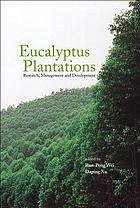|
|
|
Eucalyptus plantations: research, management and development. Proceedings of the international symposium, Guangzhou, China, 1-6 September 2002. Autor: Run-Peng Wei, Daping Xu. Singapore: World Scientific, 2003. This book contains 33 papers presented at a meeting of eucalyptus experts, scholars, consultants and company managers from different countries and regions. The following topics are reported: (1) the most recent advances in eucalyptus research from different perspectives, viz., genetics, breeding, cultivation techniques, soil nutrition, plantation management, wood utilization, etc.; (2) the worldwide extension and development of the cultivated eucalyptus as a strategic forest tree with great economic, environmental and social significance; (3) plantation management merging ecological, environmental and legal concerns in operations practised by the private sector; (4) new approaches to utilization of eucalyptus woods. This book also represents a successful combination of academic research and practical operation in managing commercial eucalyptus plantations. |
|
|
|
|
Editor: Baradat, P.; Adams, W.T.; Muller-Starck, G.
INRA, Unite de Recherche de
Biometrie, CIRAD-CP, Montpellier, France. |

